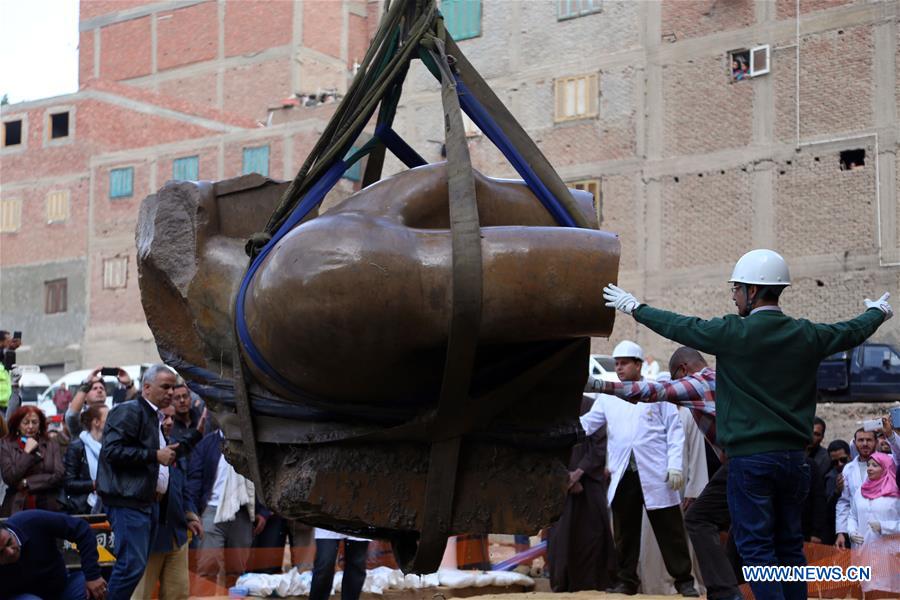
Part of a 19th dynasty royal statue is lifted by Egyptian workers at the site of a new archeological discovery at Souq Al-Khamis district in Al-Matareya area, Cairo, Egypt on March 13, 2017. According to the Ministry of Antiquities, two 19th dynasty royal statues were found in the vicinity of King Ramses II temple by a German-Egyptian archeological mission. (Xinhua/Ahmed Gomaa)
CAIRO, March 13 (Xinhua) -- An Egyptian-German archaeological mission extracted Monday the second part of a newly discovered statue, possibly of king Ramses II, from its pits in Ain Shams district of Cairo.
The colossus was carved in quartzite and found in parts in the vicinity of King Ramses II temple in ancient Heliopolis (Oun) Sun Temples in Matariya neighborhood by a German-Egyptian archaeological mission.
The 26-foot statue is believed to be associated with Ramses II, who ruled for 66 years from 1279 to 1213 BC as part of Ancient Egypt's 19th dynasty.
The first part, which almost weights three tones and includes large parts of the king's crown, right ear and a part of the right eye, was lifted out of its pit on Thursday.
Egyptian Antiquities Minister Khaled al-Anany described the discovery as very important as it shows that Oun Sun temple was rich of treasures.
"This discovery is very valuable and we will continue our excavations here in search for more antiquities," the minister told Xinhua.
For his part, Dr. Dietrich Raue, head of the German mission, said that Oun Sun Temple was subjected to damages during the Greco-Roman time and early Coptic time as most of its obelisks and colossi were transported to Alexandria and Europe.
During the Islamic era, he said, the blocks of the temple were used in the construction of Historic Cairo.
Meanwhile, Aymen Ashmawy, head of the Egyptian archaeological team, said the mission is working hard to lift-up the newly discovered statues to be later transported to the nearby Matariya obelisk archaeological site for restoration.
"More excavation work to search for other statues and artifacts is taking place to reveal more of the city's secrets," he said.
Head of First Aid Conservation at the Grand Egyptian Museum Eissa Zidan said the team extracted a water sample where the statue was found and determined that the water was from neutral to alkaline.
"This knowledge will allow the team to take the appropriate steps to preserve the statue," he said in a press statement.
Zidan added that the first part of the statue has been packed in treated materials, and will undergo a process of wetting with neutral water and perforation to ensure that it adapts gradually to an above-ground environment.
Egypt, one of the most ancient civilizations, has been working hard to preserve its archaeological heritage and discover the secrets of the archaeology of Pharaohs and other ancient civilizations across the country.
It's in a bid to revive the country's ailing tourism sector which has been suffering an acute recession over the past few years due to political turmoil and relevant security issues.
The North African country netted 6.1 billion dollars in tourism revenues in 2015, a drastic downturn from 12.5 billion in 2010, according to the country's Central Agency for Public Mobilization and Statistics.
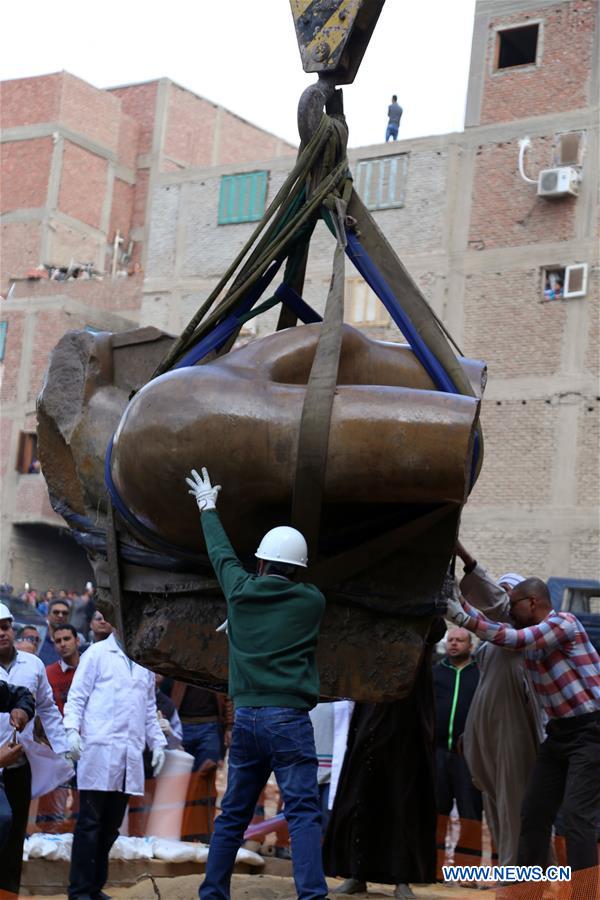
Part of a 19th dynasty royal statue is lifted by Egyptian workers at the site of a new archeological discovery at Souq Al-Khamis district in Al-Matareya area, Cairo, Egypt on March 13, 2017. According to the Ministry of Antiquities, two 19th dynasty royal statues were found in the vicinity of King Ramses II temple by a German-Egyptian archeological mission. (Xinhua/Ahmed Gomaa)
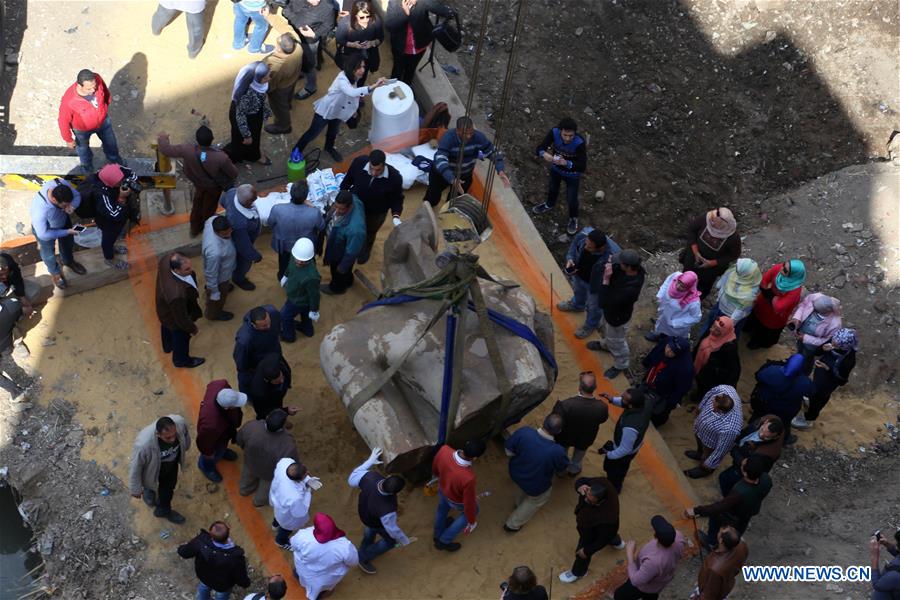
Part of a 19th dynasty royal statue is lifted by Egyptian workers at the site of a new archeological discovery at Souq Al-Khamis district in Al-Matareya area, Cairo, Egypt on March 13, 2017. According to the Ministry of Antiquities, two 19th dynasty royal statues were found in the vicinity of King Ramses II temple by a German-Egyptian archeological mission. (Xinhua/Ahmed Gomaa)
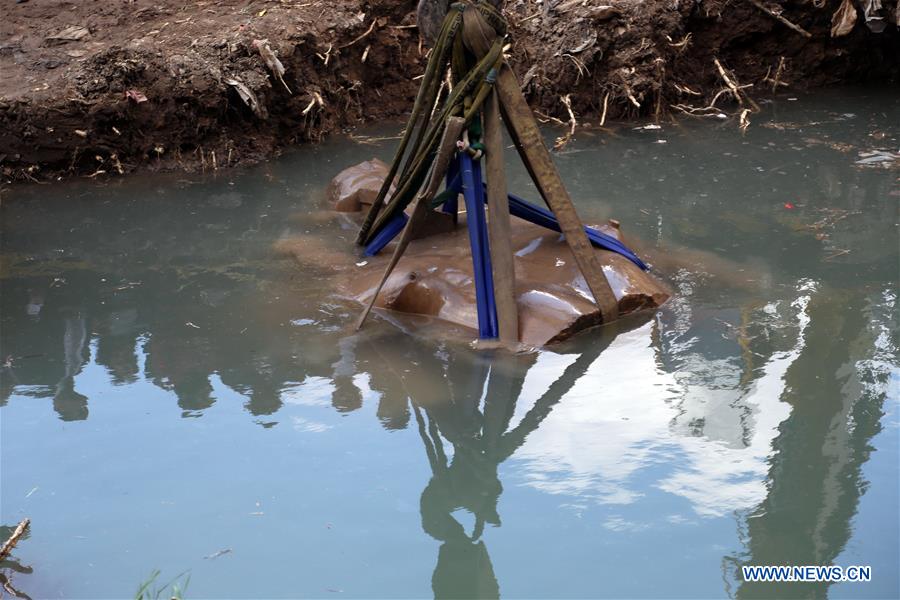
Part of a 19th dynasty royal statue is lifted by Egyptian workers at the site of a new archeological discovery at Souq Al-Khamis district in Al-Matareya area, Cairo, Egypt on March 13, 2017. According to the Ministry of Antiquities, two 19th dynasty royal statues were found in the vicinity of King Ramses II temple by a German-Egyptian archeological mission. (Xinhua/Ahmed Gomaa)
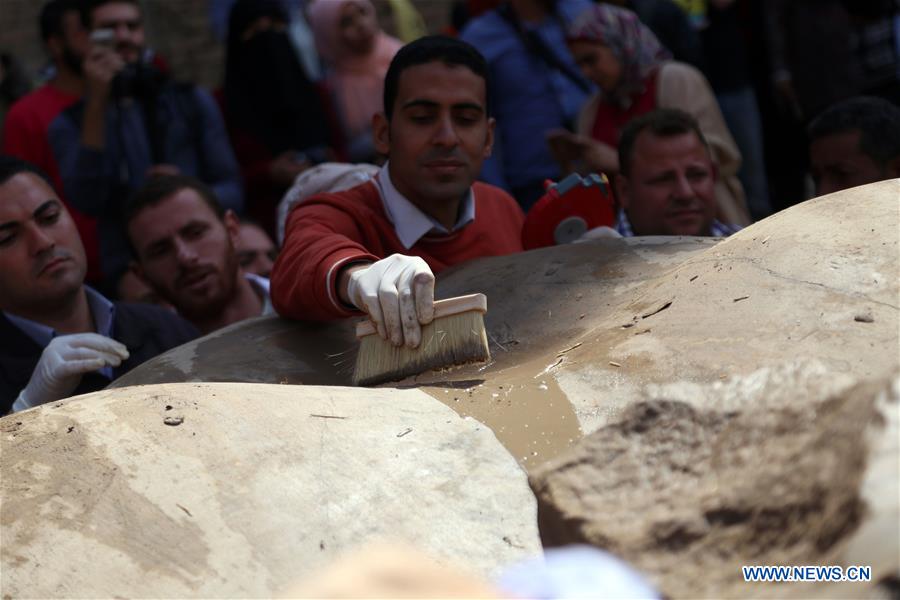
Egyptian workers clean a part of a 19th dynasty royal statue at the site of a new archeological discovery at Souq Al-Khamis district in Al-Matareya area, Cairo, Egypt on March 13, 2017. According to the Ministry of Antiquities, two 19th dynasty royal statues were found in the vicinity of King Ramses II temple by a German-Egyptian archeological mission. (Xinhua/Ahmed Gomaa)